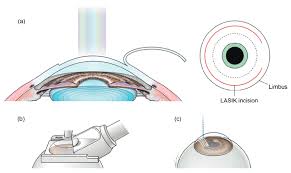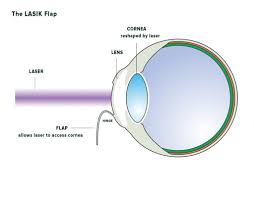Table of Contents
ToggleSMILE (Small Incision Lenticule Extraction) surgery has become increasingly popular as a minimally invasive and effective technique for correcting refractive errors, such as nearsightedness (myopia) with or without astigmatism.
While many patients experience significant vision improvement following SMILE surgery, it is important to note that some individuals may still have residual astigmatism after the procedure.
In this article, we will explore the topic of astigmatism after SMILE surgery in detail, providing valuable insights and information for those who are considering or recovering from the procedure. Our aim is to empower readers with knowledge, enabling them to navigate this situation with confidence.
What is SMILE Surgery?
SMILE surgery, a laser vision correction procedure, aims to reshape the cornea to enhance its light-focusing ability on the retina. Unlike traditional LASIK procedures, SMILE involves creating a small incision in the cornea using a femtosecond laser to remove a disc-shaped piece of corneal tissue called a lenticule.
This innovative technique reduces reliance on glasses or contact lenses while achieving the same desired outcome.
The Basics of Astigmatism
Astigmatism, a common refractive error, occurs when the cornea or lens has an irregular shape. In astigmatism, the cornea becomes oval or oblong, causing light rays to focus differently in various directions. As a result, vision becomes blurry or distorted at different distances.
Managing Expectations
Managing expectations is crucial for individuals considering SMILE surgery for astigmatism correction.
While SMILE surgery primarily targets myopia, it can also correct astigmatism simultaneously, although certain cases may present challenges and may necessitate additional procedures or complementary treatments. It is essential to have a clear understanding of the potential outcomes and have an open discussion with your healthcare provider.
However, it’s important to note that astigmatism after SMILE surgery is relatively uncommon. When it does occur, it is usually mild and can be effectively managed.
Factors Influencing Astigmatism Post-SMILE
Several factors can contribute to the development or persistence of astigmatism following SMILE surgery. These factors encompass:
- Pre-existing High Astigmatism:
Research indicates that SMILE may have slightly reduced effectiveness in correcting higher degrees of astigmatism (>5 diopters). Such patients may still experience residual astigmatism after SMILE, which could be higher compared to other laser procedures such as LASIK, resulting in a higher likelihood of requiring re-treatment. Surgeons typically discuss these potential outcomes during the pre-operative consultation. - Ocular Surface Disease:
The accuracy of the laser and the healing process can be influenced by dry eye or other pre-existing ocular surface conditions, which may result in astigmatism. - Surgical Technique:
The surgeon’s skill and precision in performing the procedure play a crucial role in minimizing astigmatism. Also, employing state-of-the-art laser technologies and implementing up-to-date surgical techniques can enhance the overall results. - Incomplete Correction:
There are cases where the initial surgery fails to achieve the desired outcome. The laser may not completely reshape the cornea as intended, resulting in under-correction of astigmatism. Additionally, if a portion of the intended tissue lenticule is not fully removed, it can lead to induced astigmatism. To address this complication, patients have undergone effective treatment with transepithelial phototherapeutic keratectomy. - Ocular Residual Astigmatism:
Ocular Residual Astigmatism (ORA) is the term used to describe the disparity between refractive and corneal astigmatism.
A recent study examined the impact of ORA on astigmatism correction in SMILE procedures, revealing a correlation between higher ORA values and increased manifest astigmatism after surgery. - Healing Response:
Each individual’s cornea responds differently to the healing process. In some cases, the cornea may undergo changes during the recovery period, leading to variations in astigmatism. - Other Factors:
There are several other factors that may influence the effectiveness of SMILE in correcting astigmatism. These factors include the center of the optic zone, the curvature of the anterior cornea, cyclotorsion, patient positioning, angle kappa, and the location of the incision.
Symptoms of Astigmatism After SMILE
- Experience blurred vision, particularly at night or in low light conditions.
- Difficulty focusing on objects, whether they are near or far.
- Frequent headaches or eye strain.
- Notice glare and halos around lights.
Addressing Residual Astigmatism
If you experience astigmatism after undergoing SMILE, there’s no need to panic.
- Consult Your Ophthalmologist:
Make an appointment with your eye doctor to discuss your symptoms and undergo a comprehensive eye examination. They will assess the degree of astigmatism and determine the most suitable course of action. - Observation:
In some cases, minor astigmatism may improve naturally within a few weeks or months as the cornea continues to heal. Your doctor may recommend observing the condition and scheduling regular follow-up appointments during this period. Effective communication between the patient and the surgical team is crucial to ensure a positive post-operative experience. If the astigmatism is significant and bothersome, there are potential options to address this issue: - Enhancement Procedures:
Your doctor may recommend a follow-up enhancement procedure. This usually involves a similar laser treatment or CIRCLE enhancement procedure, corneal refractive surgery, or PRK to refine the initial correction and further address astigmatism. Surgeons carefully assess the patient’s condition before recommending additional interventions. - Toric Contact Lenses:
For those with residual astigmatism, temporary relief can be found in toric contact lenses, providing clear and comfortable vision. Optometrists work closely with patients to determine the most suitable contact lens prescription.
Patient Education and Informed Decision-Making
Prior to undergoing SMILE surgery, it is crucial for patients to actively participate in the decision-making process. Patient education plays a vital role in this regard, encompassing several key elements:
- Thorough Consultations:
Surgeons should provide comprehensive information regarding the potential outcomes, risks, and limitations associated with SMILE surgery. - Realistic Expectations:
Setting realistic expectations pertaining to astigmatism correction and the possibility of enhancement procedures is essential to ensure patient satisfaction. - Post-Operative Care Guidelines:
Clear and concise instructions for post-operative care enable patients to actively contribute to their recovery process. By adhering to these principles, patients can make informed decisions and optimize their overall experience with SMILE surgery.
Additional Tips
- Maintain Optimal Eye Hygiene:
Incorporate the use of artificial tears to alleviate dry eye symptoms, which can exacerbate astigmatism. - Safeguard Your Precious Eyes:
Shield your eyes from harmful UV rays and wind by wearing sunglasses, as these elements can provoke irritation in dry eyes. - Refrain from Eye Rubbing:
Avoid rubbing your eyes, as it can intensify corneal irritation and impede the healing process. - Exercise Patience:
Patience is key during the healing phase after SMILE surgery. Allow your eyes ample time to recover and adapt to their new shape.
Navigate with Confidence
SMILE surgery represents a groundbreaking breakthrough in vision correction. However, it is crucial for patients to be well-informed about the possibility of residual astigmatism. While experiencing astigmatism after SMILE may cause some unease, it is important to bear in mind that it is often manageable. Most cases are mild and tend to improve with time or additional treatment.
By gaining a comprehensive understanding of the factors that influence astigmatism after SMILE, as well as the associated symptoms and available management options, patients can navigate the post-operative period with increased confidence.
Maintaining regular communication with the surgical team and adhering to post-operative care guidelines are pivotal in achieving the best possible visual outcomes. It is always advisable to consult a qualified eye care professional for personalized advice based on individual circumstances.













